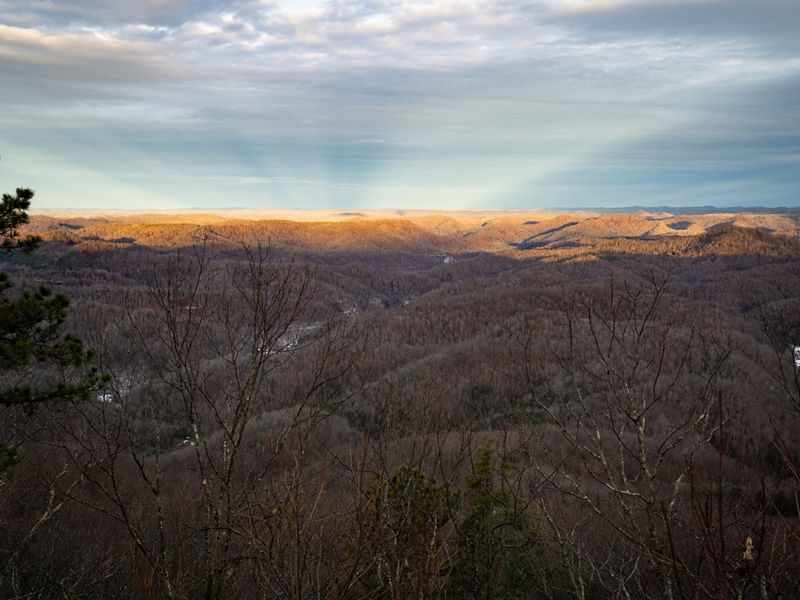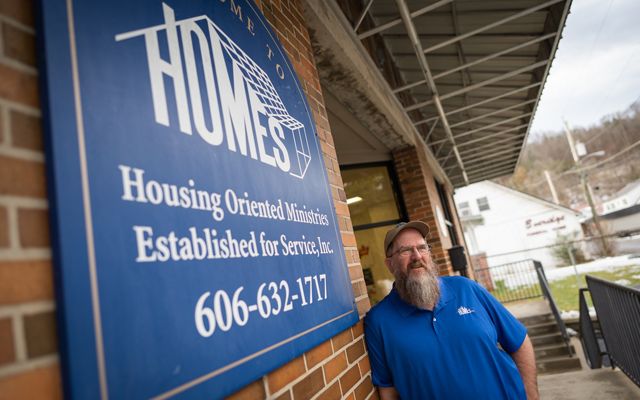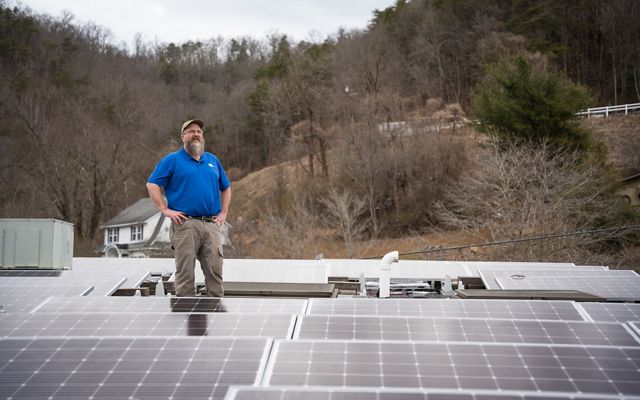
History and Transition The Appalachians have long been known for coal and the proud heritage of the people who have mined it in states like Kentucky. But a quiet shift is taking place as solar panels begin to dot its hilly landscapes. © Mike Wilkinson
The Appalachians have long been known for coal and the proud heritage of the people who have mined it. But a quiet shift is taking place as solar panels begin to dot its hilly landscapes.
For some, solar is more than just an energy transition. It is a way to make ends meet. This is especially the case for those affected by the 2022 flood in eastern Kentucky, when thousands of people lost their homes.
Rebuilding after the flood with their characteristic resilience and adaptation, many Kentuckians are redefining their relationship with energy. One of those people is Bobby Stallard. A retired carpenter and former coal miner, he is moving into a newly built efficient home equipped with rooftop solar.
“I was in a mobile home before the flood. It had been in the family since the early ‘70s. I had been working on it and it was in pretty good shape when the flood hit. The flood took everything.”
“I had a wood shop that’s still there, or what’s left of it. The flood lifted it off the foundation. I’ve been trying to clean up the tools. I was working on fixing it all up, but they told me to stop what I was doing. The flood zoning changed. We weren’t in a flood zone then, but we are now. If there’s another flood, this would happen again. We were talking about relocating, but I’m not giving my woodshop up for nobody. That’s the one thing I can do. I walk with a cane, but I can build things in my shop.”
“I got a call asking do I want to be on the list to get me into a house and I said, ‘I sure do!’ And now it’s in the exact same spot but it’s at least six feet off the ground. It’s way above what’s considered a flood zone. And it has solar panels.”
“I’ve never dreamed of this. I’m flabbergasted! We were living in a mobile home. We were used to having $500 - $600 power bills in the wintertime. On average it was about $200 a month. Every time we paid those bills, we had little left. Now with the solar panels it’s $21. That’s terrific.”
Like most people in the area, Bobby is part of Kentucky’s energy history.
“Everybody here has worked in coal at one time or another. My dad was a retired coal miner. My grandfather on my mother’s side was a retired coal miner. I’ve worked in a coal mine. That’s our legacy.”
Quote: Bobby Stallard
As far as I’m concerned, solar is one of the best things they’ve come up with in recent years. Most of the people I talk to are all for solar and things of that nature. They’re all really happy. They say, ‘man, I can’t believe you’ve got solar panels!’
Bobby’s home was built by HOMES Inc., a local nonprofit that provides affordable housing solutions for people in Letcher County. The executive director, Seth Long, recently added solar panel installations to the list of HOMES Inc. services.
But Seth wasn’t always bought in on solar.
“It wasn’t too many years ago that I was a real solar skeptic. I knew it worked on the west coast or places where it was sunny. I didn’t think it would work in this hilly coal community. About 15 years ago my mind started to change.”


“In 2008, the recession hit, and people started using less energy to save money. Power plants switched from coal to cheaper forms of energy. When that happened, most of the coal mines here shut down. So, people left looking for jobs.”
Extracting coal from the earth is an energy intensive process that uses a lot of electricity. With many mines closing, power companies were losing some of their biggest customers. When an electric utility experiences such a loss, it often means higher energy costs for the remaining customers.
“That’s when electricity prices started to go up. Our small nonprofit was paying $1,600 a month to keep the lights on in the office. Rooftop solar started rising to the top as a solution to save money. I was skeptical at first, but we borrowed money and installed panels on the roof. And it did better than we thought. It was kind of like seeing is believing.”
Quote: Seth Long
Kentucky's single industry has been coal mining. But people mostly say, ‘Hey, if solar can save money, we’re for it.’ With relief grants and tax credits, this could be a real help to our small businesses that we desperately need in these small communities.
Some of these tax credits come from the Inflation Reduction Act of 2022, which includes $370 billion in clean energy investments over ten years. When installing solar at their home, taxpayers can claim a federal tax credit of 30% of the solar project cost.
The Nature Conservancy (TNC) successfully advocated for this legislation and the tax credits within it. We continue to champion U.S. policies that bring climate and conservation investments to communities.
Policies like the Inflation Reduction Act do more than just make it easier to pursue clean energy options. They also help grow the economy by providing jobs. Research conducted by TNC found that the Inflation Reduction Act would support nearly 537,000 jobs annually for a decade. One of those jobs is building new renewable energy projects.
“People really just want to make a living and provide for their families. There’s a young man we call Fuzz who was working on becoming a master electrician. I tapped him on the shoulder and said, ‘You’re going to go to school and become a solar installer.’ If this trend continues, we’ll need more solar developers. There’s a lot of room for growth.”
“Here in Kentucky, we’ve always been an energy provider and an energy leader. Solar can play a real part in our future. We can continue being an energy leader by adapting to renewables.”
Global Insights
Check out our latest thinking and real-world solutions to some of the most complex challenges facing people and the planet today.


















